Day 12 - Friday 9/23/05
Today was dedicated to the two-hour drive out to Masada, on the western shore of the Dead Sea, and the exploration of the site through the afternoon, followed by the drive back to Rechovot. The drive was a dual landmark in that it was out first trip without our trusty Dekel chauffeur & tour guide duo, and it was John's first time driving in Israel.
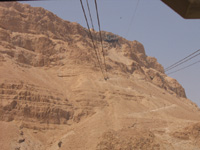
|
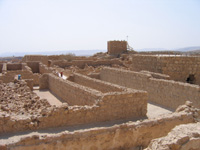
|
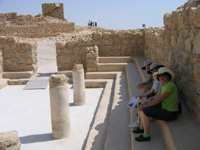
|
Masada
We arrived without incident to the ancient fortress on the edge of the Judean Desert overlooking the western edge of the Dead Sea, and rode the cable car up to the top of the mountain (we had a lovely view of the Snake Path from the cable car, but had no desire to even attempt the climb in the heat of the day). At the top, my parents and I were pleasantly surprised at the differences between the present site and what we remembered from our last trip here. My nine year-old memory supplied visions of piles of rocks and rubble, no signs, no visitor facilities, and one lone spigot protruding from a wall providing odd-tasting warm water on a 100 plus degree-day. Now, amazed, we looked out upon reconstructed buildings (with a thick black line on the walls showing what had previously been present) that were well labeled in multiple languages, shade structures and cold filtered water, restrooms, and a wheelchair-accessible path. We all agreed that the reconstructed buildings made it a much more personal experience as one could really picture life in Herodian times as well as during the Great Revolt in a way that piles of rubble just didn't convey.
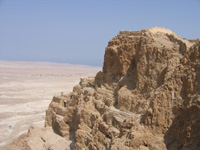
|
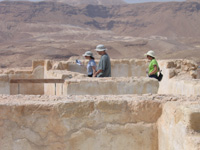
|
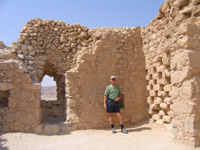
|
King Herod built Masada between 37and 31 BCE as a refuge for himself should his Jewish subjects rise up against him. In 66CE, at the beginning of the Jewish uprising against the Romans, a group of Jewish rebels called the Sicarii took Masada from the Roman garrison stationed there. Then, in 72 CE, the Romans marched against Masada and laid siege to the fortress. They built a circumvallation wall and then a rampart against the western face of the plateau, using thousands of tons of stones and beaten earth. The ramp was complete in the spring of 73 CE after approximately two to three months of siege, allowing them to finally breach the wall of the fortress with a battering ram. When the Romans entered the fortress, however, they discovered that its approximately one thousand defenders had set all the buildings but the food storerooms ablaze and committed mass suicide rather than face certain capture and defeat and slavery by their enemies. The defenders were rumored to draw lots and slay each other in turn, down to the last man, who would be the only one to actually take his own life. The argument is made that the storerooms were left standing to show that the defenders retained the ability to live and chose the time of their death.
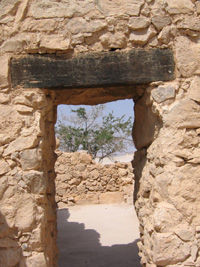
We were able to view the entire fortress. Herod had built an amazing winter palace on three terraces over the north wall, as well as storerooms where archaeologists found a huge array of food in amphorae preserved by the arid environment, water cisterns, a bathhouse, a columbarium tower where pigeons were raised for food, and a casement wall around the entire fortress. The rebels lived in rooms in the wall and constructed a synagogue and mikvehs (ritual baths). In the 5th century CE the Byzantines built a monastery that was inhabited by hermits.
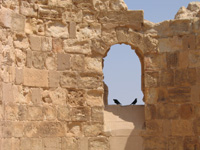
Masada was inscribed on the UNESCO World Heritage List in 2001. The tragic events of the last days of the rebels at Masada transformed it into both a Jewish cultural icon and a symbol of humanity's continuous struggle for freedom from oppression. Every year, thousands of Israeli soldiers take an oath there: "Masada shall not fall again."
Visit with Yinon & Ravit
Yinon Dekel is the middle son of Shula and Itzik. He and his wife Ravit and their two children joined us for dinner. Earlier in the week we had visited the site of their new home currently under construction, a large structure with a lovely view of orchards on the end of a cul-de-sac. We fell in love with their Italian floor tiles and are looking into the feasibility of using them in our own remodel.
<<--- Yesterday |
Tomorrow --->> |
| Copyright © 2005 by Oreet Herbst and John Knott |